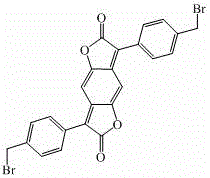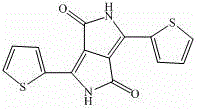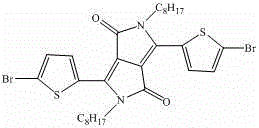Copolymer donor material for photoactive layer of polymer solar cell and preparation method thereof
A technology for solar cells and photoactive layers, which is applied in the fields of electrical solid devices, semiconductor/solid-state device manufacturing, circuits, etc., can solve the problems of low degree of conjugation, poor solubility, and harsh synthesis conditions, so as to improve the degree of conjugation, Effect of high degree of conjugation, enhanced solubility and processability
- Summary
- Abstract
- Description
- Claims
- Application Information
AI Technical Summary
Problems solved by technology
Method used
Image
Examples
Embodiment 1
[0030] 1) Synthesis of 2-hydroxyl-2-(4-methylphenyl)acetic acid
[0031] Add 4-methylbenzaldehyde (0.1 mol), chloroform (0.2 mol) and benzyltriethylammonium chloride (0.2 mol) at a molar ratio of 1 : 2 : 2 into a 250 mL three-neck flask, and then slowly 5 mL of 50% aqueous sodium hydroxide solution was added dropwise, and the temperature was controlled at 52 °C for 7 h. After the reaction, the reaction mixture was poured into 50 mL deionized water for dilution, and extracted twice with ether. The aqueous layer was acidified with sulfuric acid to a pH of 1, and then extracted twice with ether. After the ether was evaporated from the extract, it was dried in vacuo to obtain 2-hydroxy-2-(4-methylphenyl)acetic acid with a yield of 91%.
[0032] 2) Synthesis of 3,7-bis-(4-methylphenyl)benzo[1,2-b:4,5-b’]difuran-2,6-dione
[0033] Add hydroquinone (20 mmol), p-methylmandelic acid (100 mmol), and sulfuric acid (40 mmol) at a molar ratio of 1:5:2 into a 250 mL three-necked flask. A...
Embodiment 2
[0048] 1) Synthesis of 2-hydroxyl-2-(4-methylphenyl)acetic acid
[0049] Add 4-methylbenzaldehyde (0.1 mol), chloroform (0.2 mol) and benzyltriethylammonium chloride (0.3 mol) at a molar ratio of 1 : 2 : 3 into a 250 mL three-neck flask, and then slowly 7 mL of 50% aqueous sodium hydroxide solution was added dropwise, and the temperature was controlled at 55 °C for 9 h. After the reaction, the reaction mixture was poured into 80 mL deionized water for dilution, and extracted twice with ether. The aqueous layer was acidified with sulfuric acid to a pH of 1, and then extracted twice with ether. After the ether was evaporated from the extract, it was dried in vacuo to obtain 2-hydroxy-2-(4-methylphenyl)acetic acid with a yield of 94%.
[0050] 2) Synthesis of 3,7-bis-(4-methylphenyl)benzo[1,2-b:4,5-b’]difuran-2,6-dione
[0051] Add hydroquinone (20 mmol), p-methylmandelic acid (100 mmol), and sulfuric acid (80 mmol) at a molar ratio of 1:5:4 into a 250 mL three-necked flask. A...
Embodiment 3
[0066] 1) Synthesis of 2-hydroxyl-2-(4-methylphenyl)acetic acid
[0067] Add 4-methylbenzaldehyde (0.1 mol), chloroform (0.3 mol) and benzyltriethylammonium chloride (0.4 mol) at a molar ratio of 1 : 3 : 4 into a 250 mL three-neck flask, and then slowly 10 mL of 50% sodium hydroxide aqueous solution was added dropwise, and the temperature was controlled at 60 °C for 10 h. After the reaction, the reaction mixture was poured into 90 mL deionized water for dilution, and extracted twice with ether. The aqueous layer was acidified with sulfuric acid to a pH of 2, and then extracted twice with ether. After the ether was evaporated from the extract, it was dried in vacuo to obtain 2-hydroxy-2-(4-methylphenyl)acetic acid with a yield of 90%.
[0068] 2) Synthesis of 3,7-bis-(4-methylphenyl)benzo[1,2-b:4,5-b’]difuran-2,6-dione
[0069] Add hydroquinone (20 mmol), p-methylmandelic acid (200 mmol), and sulfuric acid (80 mmol) at a molar ratio of 1:10:4 into a 250 mL three-necked flask....
PUM
 Login to View More
Login to View More Abstract
Description
Claims
Application Information
 Login to View More
Login to View More - R&D
- Intellectual Property
- Life Sciences
- Materials
- Tech Scout
- Unparalleled Data Quality
- Higher Quality Content
- 60% Fewer Hallucinations
Browse by: Latest US Patents, China's latest patents, Technical Efficacy Thesaurus, Application Domain, Technology Topic, Popular Technical Reports.
© 2025 PatSnap. All rights reserved.Legal|Privacy policy|Modern Slavery Act Transparency Statement|Sitemap|About US| Contact US: help@patsnap.com



